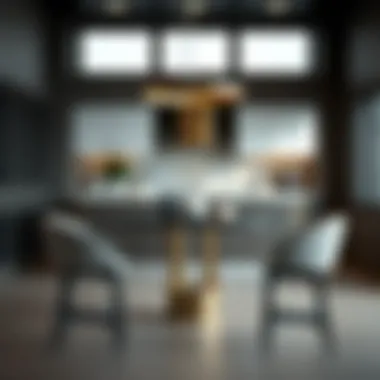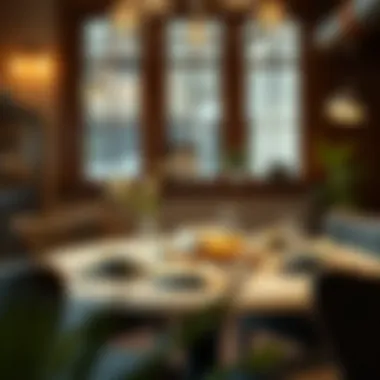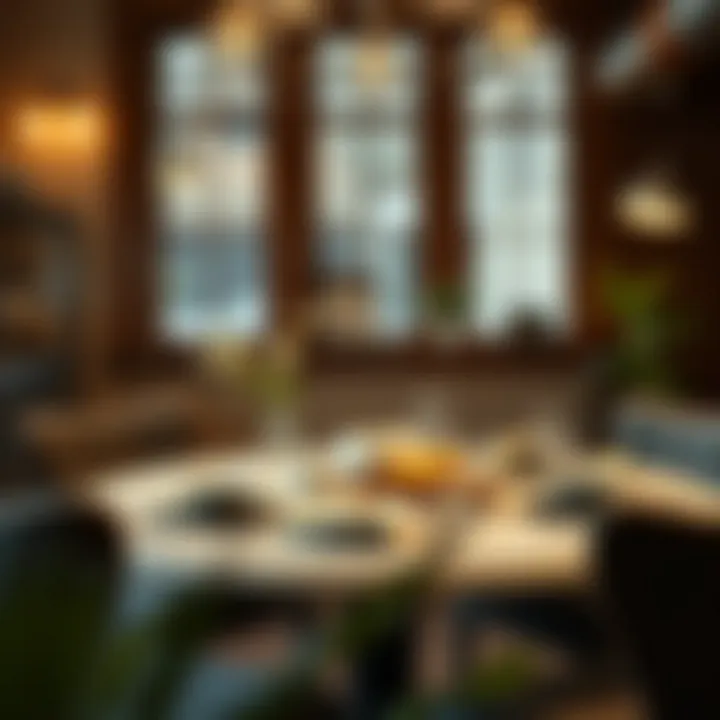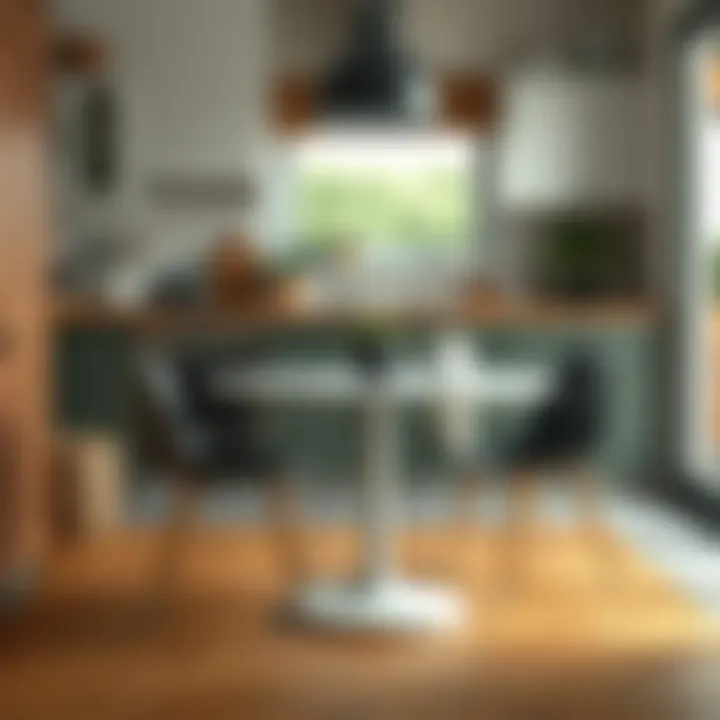Exploring the Versatility of a 30-Inch Round Kitchen Table


Intro
A 30-inch round kitchen table may seem unassuming at first glance, but don't let its modest size fool you. This piece of furniture can be a powerhouse of functionality and style within a home. It caters not only to the practical need for space but also manages to inject character into the kitchen—an area often considered the heart of the home. Different folks from homeowners to interior designers see this type of table as a versatile solution suitable for a myriad of settings.
Over the years, the design of kitchen tables has evolved considerably. The round shape offers a unique advantage by promoting intimacy and conversation, allowing for a comfortable dining experience even in small spaces. Coupling its design with modern materials and technological advancements, homeowners can select options that complement their personal style while addressing practical usage. This article aims to unpack those layers and showcase how a 30-inch round kitchen table can transcend its basic purpose.
Design Trends
Contemporary Styles
In the realm of modern design, clean lines and simplicity reign supreme. A 30-inch round table in a minimalist design can perfectly suit sleek, contemporary kitchens. Think light woods, metals, and monotones—all merging to create a look that is both chic and functional. For instance, a table crafted from bamboo or lighter oak enhances brightness, making the space appear larger. Such materials not only promote an airy feel but also resonate with eco-friendly principles that many modern consumers value.
"Furniture reflects the trends of the time, it’s like a mirror to our collective tastes."
Consider materials like powder-coated steel for the legs complemented by a glass top, which juxtaposes durability with a light aesthetic. This table style often encourages flexibility in seating arrangements too, making it easier to adapt your space for gatherings or quieter meals.
Vintage Inspirations
On the flip side, the charm of a 30-inch round kitchen table can draw inspiration from vintage aesthetics. Imagine rich mahogany or cherry wood tables that come with intricate carvings, evoking a sense of nostalgia and warmth. Vintage tables often come with a story, each scratch or mark telling tales of family dinners or memorable events. These pieces not only provide utility but also serve as conversation starters, enriching the ambience of any gathering place.
Decorating around a vintage table doesn’t need to break the bank. Utilizing upholstered chairs in various patterns can lend that rustic vibe while still keeping a modern twist. As antiques become hot commodities again, scoring a unique round table at an estate sale or flea market offers both sustainability and individuality to one’s home decor.
Material Innovations
Sustainable Materials
The push for sustainability has led to innovative materials in the furniture industry. More consumers are leaning towards tables made from reclaimed wood, bamboo, or composite materials that reduce environmental impact. Reclaimed wood tables bring character, with each piece possessing its own unique markings and colors. The eco-conscious consumer looks not just for style but for a connection to nature, with sustainable design methods aligning perfectly with this philosophy.
Smart Furniture Technology
As technology continues to infiltrate everyday spaces, smart tables are making waves. Imagine dining surfaces that integrate wireless charging capabilities or built-in lighting features, enhancing functionality while retaining elegance. A slim, round table with wireless charging pads can reduce clutter from cables while making it look sleek. This fusion of traditional styles with high-tech amenities opens the door for a new kind of dining experience, seamlessly merging comfort and modern efficiency.
For those looking to delve deeper into design trends, check out resources like Encyclopedia Britannica or visit local furniture galleries to experience various styles firsthand.
Preamble to Kitchen Tables
Kitchen tables have always been at the heart of the home, serving not just practical needs but also social ones. They are places where meals are shared, vital conversations unfold, and memories are created. The importance of this article lies in exploring the various dimensions that a kitchen table can offer, particularly the unique charm of a 30-inch round table.
Historical Context of Kitchen Furniture
Looking back, the kitchen furniture has evolved drastically over the centuries. In the past, the kitchen was a purely utilitarian space. Tables were often simple, wooden planks laid across trestles. Families gathered around these basic designs for meals, often in communal homes where food and love were shared alike.
During the Renaissance, craftsmanship took center stage, and this was reflected in the highly decorated dining tables. Ornate designs were prevalent, often showcasing the homeowner's wealth. Those colossal tables would often dominate the room, essentially giving the kitchen a rigid and formal air. It wasn't until the 19th century that we started seeing a shift towards more personal spaces, making way for cozier kitchen settings.
Interestingly, different cultures have their unique takes on kitchen tables. In some Asian households, for instance, a low coffee table is preferred, where family members often sit on cushions. Each culture’s dining table reflects its history and norms, making the kitchen table a fascinating artifact of social evolution.
Evolution of Table Designs
The design of kitchen tables has transitioned from mere utility to a blend of aesthetics and function. The 20th century brought in modernist thoughts that championed clean lines and minimalism. No longer were tables just a place to eat; they became stylish centerpieces that aligned with the rest of the home decor.
Then came the post-war era, where the kitchen table became synonymous with family gatherings. It turned into a multifunctional space—not just for dining but also for homework, board games, and even crafting projects. The round table, in particular, gained popularity during this period. Its lack of corners encouraged inclusivity, allowing everyone to be equal participants in conversations.
Today, the personalization of kitchen tables is at an all-time high. It’s not uncommon to see tables made from reclaimed wood, handcrafted designs, or uniquely shaped glass tables. People are more eager to express their individuality through their kitchen tables than ever before.
In summary, understanding the historical context and evolution of kitchen tables paves the way for appreciating the charm of a 30-inch round table within modern kitchens. This small yet significant piece of furniture embodies countless stories and functions, making it an essential consideration for anyone looking to create a welcoming kitchen space.
Why Choose a Round Kitchen Table?
When pondering the essentials of kitchen furniture, the choice of a round kitchen table stands out distinctly. This decision isn’t merely about aesthetics; rather, it embodies a blend of practicality and conviviality. Understanding the factors that underscore the selection of a round table sheds light on its multifaceted nature. Here, we explore the reasons why this particular shape is a sensible investment for any home.
Benefits of Round Tables
Space Efficiency
In a world where square footage can feel as tight as a drum, space efficiency becomes paramount. A 30-inch round kitchen table is like the Goldilocks of dining options—not too big, not too small, but just right for snug kitchens. Unlike square or rectangular tables, round tables eliminate sharp corners, allowing for smooth flow around the area.
This circular shape also tends to maximize usable space. Whether tucked into a corner for a cozy breakfast nook or positioned in the center of an open plan kitchen, a round table makes the most of every inch. With adaptable seating arrangements, you can squeeze in a couple of extra chairs when needed without losing the intimate ambiance.
Enhanced Social Interaction
It is said that good conversations are like good wine—they get better with the right setting. Enter the round kitchen table. The absence of corners creates a welcoming atmosphere where guests can easily engage with one another. Everyone feels equal at a round table, fostering closeness during shared meals and thus enhancing social dynamics.


This design promotes eye contact and easy banter, allowing everyone around the table to feel included. A simple meal transforms into a delightful gathering, a painting where all are part of the scene rather than mere observers.
Versatility in Use
Whether employed as a catching spot for homework, a crafting area, or a casual dining spot, the versatility in use of a round table can’t be underestimated. This unique characteristic makes it a chameleon in home décor, adaptable to various needs beyond just meals.
From stylish game nights with friends to family breakfasts, round tables fit right in. They shine in functionality, adjusting to diverse lifestyles and spaces, even accommodating different themes—from sleek modern to cozy rustic.
Considerations for Table Size
Room Dimensions
When it comes to room dimensions, size matters—a lot. A 30-inch round table can serve as a focal point in smaller kitchens, allowing for flow without making the space feel cramped. Precise measurements can make or break your kitchen’s function. Understanding how the table fits into the available area can spark creativity in layout.
A table that’s too large can dominate a small kitchen, making movement cumbersome, while one that’s too small may appear lost without serving its purpose. Balance is key in creating an inviting, functional space.
Seating Capacity
How many folks can you fit around the table? That’s the crux of seating capacity. A round table generally accommodates fewer guests than its rectangular counterparts, often hosting a comfortable number of four. This makes it perfect for small families or intimate gatherings.
However, it's essential to evaluate if your occasional needs may warrant a slightly larger option. Knowing whether you plan family dinners or have larger social circles can dictate your choice significantly.
Proportional Aesthetics
Finally, let’s not overlook proportional aesthetics. A round table needs to harmonize with the surrounding furniture. Its dimensions ought to complement rather than clash with the other elements in the room. A 30-inch round table aligns well with standard chairs but needs to be proportionate to the rest of the kitchen features—like cabinets and appliances.
Balancing size with aesthetic appeal will create a visual flow, making your kitchen not just a functional workspace but an inviting centerpiece in your home.
Round tables craft an atmosphere of community and togetherness, proving functionality does not have to come at the expense of beauty.
Design Elements of a 30-Inch Round Table
When contemplating the design elements of a 30-inch round kitchen table, the focus shifts beyond mere aesthetics—it encompasses how these elements contribute to the functionality and overall atmosphere of a kitchen space. This size is particularly noteworthy as it strikes a balance between intimacy and usability, making it suitable for diverse needs ranging from casual breakfasts to more formal occasions. The interplay of materials, colors, and design styles creates a versatile piece that can adapt to various kitchen themes, thus offering homeowners a unique opportunity to enhance the space’s character.
Material Choices
Wood
Wood has a timeless appeal, often seen as the cornerstone of kitchen furnishings. Its natural warmth and rich textures provide an inviting feel, making it ideal for family gatherings and leisurely meals. The various types of wood, from oak to walnut, each offer distinct characteristics; oak, for instance, is renowned for its durability and grain structure, whereas walnut is appreciated for its darker hues and sleek finish. A potential drawback lies in maintenance, as wooden surfaces may require regular treatments to prevent scratches and moisture damage. Nonetheless, the charm of wood often outweighs these concerns, making it a popular choice.
Metal
Metal, particularly stainless steel or brushed aluminum, lends a modern twist to round tables. Its sleek, shiny surface can elevate the ambiance of any kitchen, providing a stark contrast to warmer wooden elements. The key characteristic of metal is its sturdiness and ease of cleaning, making it ideal for high-traffic areas or households with kids. While it may come off as cold or industrial in some contexts, the right design can harmonize it with softer elements to balance the overall look. These tables often last a long time, although they can be susceptible to scratches and fingerprints, requiring occasional polishing.
Glass
Glass tables bring an airy feel into kitchens, making spaces appear larger and more open. They reflect light beautifully, enhancing the overall brightness of the area. A notable benefit is versatility; glass can accommodate various styles, from ultra-modern to vintage chic. One important feature to note is the different types of glass available, like tempered glass, which offers safety alongside elegance. However, fingerprints and smudges can be more noticeable on glass surfaces, possibly demanding more frequent cleaning than wood or metal options. Despite that, a well-chosen glass table could serve as a stunning centerpiece.
Color and Finish
Natural vs. Painted Finishes
The debate between natural and painted finishes can significantly influence the table's impact within a kitchen. Natural finishes celebrate the inherent beauty of the material, enhancing grain patterns and texture, while painted options allow for creative expression and customization. Homeowners can choose bright hues for a pop of color or muted tones for a more subdued aesthetic. A natural finish often provides warmth and authenticity, which can create a cozy vibe. However, painted surfaces might cater to trends better and make a bold statement. One must weigh the timeless appeal of natural aesthetics against the flexibility of painted designs when deciding.
Trends in Color Palettes
The trends in color palettes fluctuate with the seasons, and kitchen tables are no exception. Right now, earthy tones like olive green and terracotta are garnering attention, alongside softer pastels. Neutral colors, however, maintain their evergreen status as they blend seamlessly with various décor styles. Choosing a color that resonates with the overall kitchen theme can enhance harmony throughout the space. Still, a table in a daring color can provide a striking focal point. The main challenge associated with trendy colors is their potential to fall out of fashion, making it vital to consider long-term appeal in any choice.
Style Variations
Modern Minimalist
The modern minimalist style emphasizes simplicity and function. A round kitchen table that follows this design approach features clean lines, often devoid of excessive ornamentation. This choice can create an uncluttered, airy dining space, where less truly becomes more. Minimalist tables might incorporate metallic or matte finishes for added sophistication. The result is a sleek setup that caters to individuals who prefer a serene, noise-free environment in their homes. However, some might find this style too stark or impersonal, lacking a homely feel.
Rustic Charm
Counter to modern minimalism is the rustic charm style, which often pays homage to traditional craftsmanship. Round tables in this category may be made from reclaimed wood, exuding history and warmth. These tables imbue a cozy atmosphere perfect for family gatherings and casual meals. The imperfections and knots in the wood often tell a story, adding character to the kitchen. Yet, one must consider that rustic styles can sometimes come across as overly casual compared to more contemporary aesthetics.
Mid-Century Modern
Mid-century modern design bridges the gap between vintage and contemporary. Characterized by organic forms and a mix of materials, round kitchen tables of this style often incorporate vibrant colors and elegant yet functional design. They are often celebrated for their bold shapes and playful patterns, appealing to those who love a touch of the eclectic in their décor. These tables can stand out remarkably in a kitchen setting. However, this distinctive style may not resonate with everyone, making it essential to ensure compatibility with existing kitchen elements.
Choosing a 30-inch round kitchen table involves considering various design elements that can enhance both aesthetics and functionality within your home. Each material, color, and style offers unique advantages and challenges, allowing you to customize your space according to personal preferences and needs.


In sum, understanding these design elements can aid in selecting the perfect table that not only fits the kitchen but also resonates with the lifestyle and tastes of those who use it. Each choice carries its distinct flavor, significantly impacting the overall kitchen experience.
Practical Uses of a Kitchen Table
When we consider the kitchen table, it tends to be one of the central pieces in many homes. Not just a surface to eat from, a 30-inch round kitchen table functions as the epicenter of daily activity and interaction. Depending on its placement and usage, this table can significantly influence both utility and ambiance within a kitchen space. Let's explore some of the primary ways in which it can be put to good use.
Dining and Eating Spaces
In terms of dining, a 30-inch round table is well-suited for intimate meals. This size is particularly inviting for small families or couples, creating a cozy atmosphere for sharing meals. Often, it encourages a more conversational dining experience, as everyone can see each other without the awkward stretch that sometimes comes with a long rectangular table. This close proximity makes it easier to pass dishes and engage in lively discussions during meals.
Moreover, the table can double as a breakfast nook. Imagine sipping coffee while perched atop a cushioned stool—perfect for reading the morning paper or enjoying a quick bite before diving into the day.
Work and Study Areas
In our increasingly busy lives, the kitchen table emerges as a multipurpose space. It's not unusual to find people splayed out with their laptops, textbooks, or even bill payments, right on the dining table. Unlike dedicated office spaces that might feel too formal, the kitchen table offers a relaxed environment. The gentle hum of the household can be grounding while working or studying.
For students, it's a great place for homework or group study sessions. Minimal distractions in the kitchen, paired with handy access to snacks and drinks, can make it the perfect workspace. The versatility of a round table facilitates closer collaboration, whereby students can share resources easily and engage in discussions without feeling crowded.
Crafting and DIY Projects
Creative folks often know that the kitchen table can also serve as a canvas for crafting. Whether you’re scrapbooking, painting, or attempting a DIY home improvement task, the round table provides ample space without the intimidation of a larger workbench.
One major advantage is accessibility. These projects often require quick access to various materials, and being in the heart of the home allows for easy retrieval without traipsing around the house searching for supplies. Besides that, it’s more comfortable for family members to join in, so weekend projects can become treasured family activities, thus forging lasting memories as people gather to create together.
"In a home, the kitchen table is not just furniture; it’s the heart of interactions, creativity, and daily rituals."
In summary, the functional potential of a 30-inch round kitchen table is vast. By merging dining, study, and creative spaces into one focal point, it becomes an indispensable element in many homes—tailoring itself to the needs of the household while maintaining an aesthetic charm.
Placement Strategies within the Kitchen
Finding the right spot for a round kitchen table can sometimes feel like solving a puzzle. It's not merely about plunking it down in a space; it’s about creating a flow that complements both function and aesthetics. A well-placed table can transform a kitchen into a vibrant hub of activity. It allows diners and crafters alike to feel comfortable and connected. The following sections will explore optimal locations, integration with the layout, and how to create a cohesive design that enhances the kitchen environment.
Optimal Locations for a Round Table
When considering where to place a round table, think about the movement of the space and how folks will interact with it. One optimal location is in the center of the kitchen. This serves as an anchor point, drawing people in and promoting a sense of community. However, make sure it's not obstructing work areas or pathways. Ideally, you want at least three feet of clearance around the table. This makes it easy to move chairs in and out without a dance of avoidance.
Another great option is near a window. Picture this: sunlight pouring in while you enjoy your coffee or have dinner with family. However, don’t forget about potential glare—curtains or shades can make all the difference when it’s time to eat. Additionally, placing the table close to the cooking area can facilitate easy serving. Yet caution is key; ensure there’s no risk of spills or splatters migrating onto the table’s surface.
- Consider the following locations:
- Center of the kitchen for a communal vibe
- Near a window for natural light
- Close to the cooking area for convenience
Integration with Kitchen Layout
A round table needs to play well with the existing kitchen layout. For instance, if your kitchen features an L-shaped design, positioning the table at the far end can create a functional balance. It can serve to visually elongate the space, providing a pathway that feels open, rather than cramped. French kitchen layouts also benefit from this dynamic; intuitively integrating the table can welcome guests without interference to the cooking areas.
Furthermore, if cabinets or islands are present, placing the round table in proximity can provide a sense of continuity. Incorporating the table with these elements can foster a more inviting atmosphere. When the table feels integrated rather than shoehorned, the room comes together seamlessly.
- Effective strategies to integrate:
- Positioning to enhance flow between work areas
- Using nearby cabinets or islands to create symmetry
- Avoiding clutter; emphasize openness in layout
Creating a Cohesive Design
Finally, cohesion is critical for any kitchen design, and a round table must harmonize with the overall aesthetic. Consider matching the table style with the cabinetry or existing furniture. For example, if your kitchen carries a rustic vibe, opting for a wooden table with a distressed finish can bring that theme together nicely.
In addition, color plays an essential role. The table should either complement or contrast the existing color scheme tastefully. A neutral table can blend seamlessly, but an eye-catching color could serve as a statement piece. Textures matter too; mixing metals, fabrics, and finishes can add depth to the overall design but be cautious to keep it balanced.
- Key points for cohesion:
- Match the table style to existing elements
- Consider color schemes carefully
- Use texture transitions wisely to maintain harmony
In summary, finding the right placement for a round kitchen table is a thoughtful endeavor. Consider movement, integration, and cohesion to create a space that is not only functional but also visually appealing.
Maintenance and Care
Maintaining a 30-inch round kitchen table goes beyond mere aesthetics; it plays a crucial role in longevity and functionality. A kitchen table is often a focal point in a home, hosting everything from family meals to countless discussions. Proper care and maintenance extend the life of this centerpiece while preserving its appearance, ensuring it continues to serve its multifaceted nature effectively.
Keeping up with cleaning routines and care strategies not only keeps your table looking sharp but also protects it from wear and tear over time. When you invest in a round kitchen table—be it wooden, glass, or metal—you want to ensure it remains a cherished part of your home for years to come.
Cleaning Techniques per Material


Each table material requires specific care methods to keep it in top shape. Here’s how to maintain those surfaces effectively:
- Wooden Tables: For wood, gentle is the name of the game. Use a soft, damp cloth to wipe down the surface without soaking it. A mixture of vinegar and olive oil can polish up any scratches and enhance the wood's natural shine. Avoid harsh chemicals or excessive moisture, as they can warp the wood.
- Glass Tables: For a glass top, stick with a glass cleaner and a microfiber cloth to avoid streaks. You can use a simple solution of water and dish soap for regular upkeep. Always dry it with a soft cloth to keep it spotless.
- Metal Tables: When it comes to metal, a damp cloth with mild soap does wonders. Make sure the cloth is soaked but not dripping, as excess water can reach joints and cause rust. Follow up with a dry cloth to prevent water spots. For stainless steel, a specialized cleaner can help maintain that shining finish.
Additional Tip:
"Remember to assess your table's specific care instructions, as some materials may have particular needs."
Preservation of Surface Finish
Surface finish preservation is key to ensuring your kitchen table stays beautiful and functional. Common finishes like lacquer, varnish, or oil may require different care approaches:
- Regular Dusting: Schedule regular dusting of the table to prevent scratches and accumulate dirt. Use a soft rag that won’t tarnish the finish.
- Avoid Direct Sunlight: Protect your table from direct sunlight to prevent fading or discoloration. If your kitchen has ample sun, think about using curtains or blinds to diffuse that light.
- Coasters and Placemats: Simple, yet effective—using coasters and placemats can shield your table from heat, moisture, and scratches from dishes or drinks.
- Routine Reapplication: For wooden tables, occasionally reapplying the finish can help maintain the wood's integrity. Depending on the type of finish, this could mean sanding lightly and adding a new coat of oil or varnish.
By paying careful attention to maintenance and employing effective cleaning strategies designed for the material of your table, you ensure that your kitchen centerpiece not only maintains its visual appeal but also its structural integrity over time.
For more detailed guidelines on furniture care, you might find resources like Wikipedia helpful, or check out practical tips from The Home Depot for more on table upkeep.
Adopting a proactive approach in maintaining your round kitchen table will enable you to make the most of your investment while enhancing the warmth and usability of your home.
Enhancing the Dining Experience
A kitchen table isn’t just a piece of furniture. It’s often the heart of the home, where stories are shared, meals are savored, and connections are nurtured. Enhancing the dining experience at a 30-inch round kitchen table involves carefully considering various factors that contribute to its ambiance and functionality.
Table Settings and Decoration
Setting the table can turn an ordinary meal into something extraordinary. The choices made here play an essential role in enhancing the dining experience. Consider the following elements when decorating your table:
- Table Linens: Use tablecloths or runners that reflect your personal style. Whether you prefer rustic farmhouse vibes or sleek modern aesthetics, the right fabric can set the mood.
- Centerpieces: A thoughtful centerpiece can add character. Fresh flowers, a bowl of fruit, or even a collection of candles can create a visual focal point. Try mixing heights and textures for added interest.
- Dinnerware: Choose plates and utensils that align with the occasion. Special occasions call for fine china, while casual meals may suit sturdy ceramic or melamine sets. Consider color coordination to create a harmonious look.
- Lighting: The lighting around your table is crucial. Dimmed lights or soft- glowing candles contribute to a cozy atmosphere, while bright lights may be suitable for lively family gatherings. Experiment with placements to achieve the ambiance you desire.
Ultimately, how you set your table reflects your personality and the experience you want to create. A well-thought-out table setting invites guests to relax and engage.
Choosing Suitable Seating
The right seating complements a 30-inch round table perfectly. Comfort and style should go hand in hand when selecting chairs or stools. Here are some factors to consider:
- Height and Proportion: Make sure the seating height is compatible with your table height. For a 30-inch table, standard dining chairs or stools usually work well. Opt for seats that allow for comfortable legroom.
- Style Matching: The seating should harmonize with the table’s design. For instance, a rustic table might look best with wooden, farmhouse-style chairs, while a sleek metal table could pair well with modern plastic or upholstered seating.
- Comfort Level: Guests will be spending time at the table, so prioritize comfort. Cushioned seats or ergonomic designs can make long meals more enjoyable.
- Mobility and Flexibility: Depending on your space and needs, consider chairs that are lightweight and easy to move. This flexibility can enhance the table's functionality for various activities, whether it’s dining, working, or crafting.
When the seating is right, it becomes a seamless part of the dining experience, allowing everyone to gather and enjoy with ease.
"The dining experience is a reflection of the care put into every detail—table settings, seating, and atmosphere come together to build lasting memories."
By focusing on these elements—table settings and suitable seating—you not only enhance the dining experience but also create an inviting atmosphere that encourages connection and enjoyment.
Current Trends in Round Kitchen Tables
In recent years, the world of interior design has embraced a shift away from traditional, often bulky, dining arrangements to more versatile and space-conscious options. Round kitchen tables, especially those measuring 30 inches, have emerged as a favorite among homeowners and decorators alike. This trend underscores a growing appreciation for functional design that doesn’t skimp on aesthetics. As we delve into the current trends governing round kitchen tables, we will explore vital aspects that merge style with practicality, catering to the needs of modern living.
Sustainable Materials
Sustainability has etched its mark firmly into the fabric of furniture design. As concerns about the environment become more pronounced, the choice of materials for round kitchen tables is evolving. Homeowners are steering towards sustainable options that not only minimize their carbon footprint but also offer unique visual appeal.
- Reclaimed Wood: This choice often tells a story, with each scratch and knot carrying its history. Utilizing reclaimed wood means you’re not only promoting reusability but also bringing character into your space.
- Bamboo: Fast-growing and highly renewable, bamboo is another eco-friendly option gaining traction. Its lightness coupled with strength makes it a prime candidate, particularly for compact tables.
- Recycled Metal and Glass: Incorporating materials like recycled metals or glass not only enhances the modern appeal of round tables but also champions wise use of resources.
"Choosing sustainable materials doesn't have to mean sacrificing style; it simply invites a deeper connection to what surrounds us."
These choices embody an ethos of responsibility, compelling manufacturers and consumers alike to think in layers about the impact their choices have on the greater ecosystem.
Multi-functionality
The desire for multi-functional furniture is a trend that reflects a wider cultural shift towards minimalism and efficiency in home design. A 30-inch round kitchen table is particularly adept at serving a range of purposes without necessitating a large footprint. Here, flexibility becomes king.
- Dining Hub: While primarily serving as a dining area, this table can double up as a workspace for remote professionals. The ample surface makes it an excellent spot to spread out a laptop without feeling cramped.
- Crafting Table: For those inclined towards DIY crafts, the size of the round table provides just enough space to engage in hobbies such as painting or scrapbooking. Its circular shape offers better access and encourages collaboration, making it a favorite among families.
- Social Gatherings: With such a format, family or friends can cozy up around the table without any awkward angles. This practicality often enriches social interactions—a round table cultivates a sense of inclusivity.
Adapting to the fluctuating needs of users, these tables become essential to modern living. They encapsulate the essence of today’s design philosophy: furniture that breathes and transforms alongside the lives it serves, retaining elegance through every twist and turn.
In summary, the trends steering round kitchen tables today showcase a compelling blend of sustainability and versatility. As these tables take root in our homes, they invite a new chapter in kitchen design—one that values both function and aesthetics equally.
The End: The Ideal Kitchen Companion
The kitchen table serves as a cornerstone in the heart of the home. In considering the 30-inch round table, one must appreciate its nuances—not merely a piece of furniture but a versatile partner in daily life. From fostering family connections during meals to serving as a workspace for various activities, its role is multifaceted. The charm of a round table, particularly in a compact form like 30 inches, provides an opportunity to maximize space without compromising on function or style.
Final Thoughts on Design and Functionality
Design and functionality must go hand in hand when it comes to selecting a kitchen table. A 30-inch round kitchen table stands out due to its ability to adapt seamlessly to diverse settings. It invites genuine conversation, encourages interaction, and presents an inviting atmosphere for gatherings, be they intimate dinners or casual weekend brunches.
- Space Saving: When choosing a round table, one doesn’t just settle for aesthetics; it’s crucial to consider space. The rounded edges allow for easy navigation in tighter spots, making it perfect for kitchens where space might be an issue.
- Material & Style Concerns: Each material option, whether it’s solid oak or a sleek glass top, influences the overall look of the room. Thoughtful selection here enhances the kitchen’s decor while supporting durability and ease of care.
- Integration with Functionality: As a central feature, it can double as a workspace or crafting area. Its compact size encourages multifunctionality, something that’s invaluable in modern homes where resources are stretched thin.
In looking at a 30-inch round kitchen table, homeowners and designers alike should recognize its potential not just as a means to dine, but as an integral piece of home life. When selected with care, these tables bridge the gap between practicality and style, echoing the personal stories and memories created around them. For anyone considering such a table, remember that beyond the physical object lies the promise of togetherness and shared moments.















